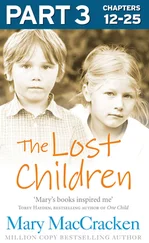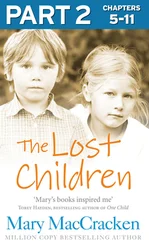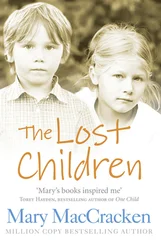In the mornings we lay in bed and blew smoke rings of warm breath into the frosty air and then rushed from bed to shiver by the window as we watched deer leap across the meadow. We ate simple meals and trudged along un-plowed roads, chopped logs and read and talked quietly to each other. Happiness was almost visible that week.
Vacation over, spring courses began. I wondered if every one had as hard a time coming back to school as I did. But I did have seventy-six credits now – five A’s and a B – and fifteen more credits coming up this semester. If I could just get through Statistics and Orientation to Psychological Testing and Background of Mathematics II, I’d have ninety-one by May. And now, thanks to Professor Foster, there would be children.
Many of the faces in Background of Mathematics II were familiar, but instead of Dr. Kaiser, the teacher was a man in his thirties, wearing black horn-rimmed glasses – and there, sleeping beneath a grubby tennis hat, was Ian Michaels. My spirits lifted.
I stepped over several pairs of blue-jeaned legs and settled beside Ian, who continued to sleep, or to pretend he did.
On the board was written Background of Math II. Beneath this was the statement:
A denumerably infinite set is one that can be put in a 1–1 correspondence with the set of counting numbers.
Oh, no. Here we go again. I had thought we’d at least be to something like fractions.
I opened my notebook and copied the statement down anyway; I could puzzle over it later.
A familiar hand reached lazily across the page and scrawled an example.
Ex: The set of multiples of 5 is a denumerably infinite set.
1, 2, 3, 4, 5, … n …
5, 10, 15, 20, 25, … 5n …
I looked at what Ian had written. Okay, I see that. I smiled at Ian’s tennis hat.
“Thank you,” I said, settling back in my chair. “The one thing I’m good at in math is knowing how to pick the right seat.”
If classes at college were as frustrating as ever, our training sessions at the clinic were fascinating.
The Mental Health Clinic was in the center of Falls City on the second floor of the Logan Building, and although the streets were littered and the surrounding buildings shabby, there was a lingering ambiance of power and elegance.
In earlier years Falls City had been a leading manufacturing center. Its chief industries were the dyeing and finishing of textiles and the manufacture of silk. But with the rising popularity of synthetic fabrics, business declined and companies closed. Although pockets of culture remained, the downtown area had become drab and rundown and the population was predominantly lower middle class.
Inside the Logan Building, shabbiness was more evident. Water stains marked the ceilings, walls needed painting, floors were bare, furniture was folding metal. But there was a lot of space, a large waiting room, several secretarial offices, and a half-dozen rooms for therapists to meet with clients. Some rooms were furnished with chairs, table, and couch; another had low furniture and toys for children. We met in the children’s room.
The other two tutors were both seniors, Shirley Hayes and John Hudson. Shirley was quiet, with a soft sure voice and dark smooth skin. Hud was tall, slender, red-haired, filled with vitality. Shirley was going on to graduate school next year, and was working now as a clerk in a department store after her college classes to earn tuition. Hud was job-hunting, hoping to teach teenagers with emotional problems. I liked them both. Hud had worked with multiply handicapped children at summer camp. Shirley with disadvantaged children at a day care center.
Jerry Cotter had been put in charge of the program and conducted our training sessions. He was small, with a brown-gray beard and a gentle handshake. His official title at the clinic was psychiatric social worker.
At our first meeting Jerry said, “This program could be the beginning of a revolutionary change in the treatment of emotional problems in children. The central idea is to expand and intensify mental health services in the schools themselves, instead of letting kids vegetate on waiting lists. We are going to try to do this through therapeutic counseling and tutoring at the school – and you are the ones who are going to do it.”
At later sessions Jerry stressed again that help would go to the child in a familiar place, his school, rather than the child going, or waiting to go, to a clinic. He also said we would not be asked to work with psychotic children, the ones who were so disturbed that they would be considered autistic or schizophrenic. He smiled at me. “These children are not as out of touch with reality as the children you’ve worked with, Mary. Instead, they take their anger out on society, stealing, burning, destroying, and earn the label of ‘socially maladjusted’ or ‘juvenile delinquent.’”
I smiled back but didn’t reply. Labels meant little to me. In fact, as far as I could see, their only use was to give a name to a program so it could be funded. Nobody funded anything without a name.
The next four sessions focused on diagnostic tests and teaching procedures. Jerry demonstrated the administration and scoring of various tests given to screen for emotional or neurologically based impairments. We, of course, did not have the skill to score the tests ourselves, but we were all amazed at how much information he was able to obtain from such seemingly simple devices.
Our last session was on observing and charting behavior. Jerry gave us stopwatches and taught us how to use observation charts, marking down the number of incidents of a child’s disruptive behavior during short intervals carefully timed by the stopwatch.
At the end of this session, Jerry said, “That’s it. I, of course, will be at the school scoring tests and supervising from time to time. The grant covers the rest of this year and I’ll get over as much as I can, but we’re short-handed here and you’re going to be more on your own than originally planned.
“Anyway, good luck. I’ve enjoyed our sessions together and I’ll see you all at School Twenty-three on Wednesday.”
How could I wait till Wednesday?
Конец ознакомительного фрагмента.
Текст предоставлен ООО «ЛитРес».
Прочитайте эту книгу целиком, купив полную легальную версию на ЛитРес.
Безопасно оплатить книгу можно банковской картой Visa, MasterCard, Maestro, со счета мобильного телефона, с платежного терминала, в салоне МТС или Связной, через PayPal, WebMoney, Яндекс.Деньги, QIWI Кошелек, бонусными картами или другим удобным Вам способом.












